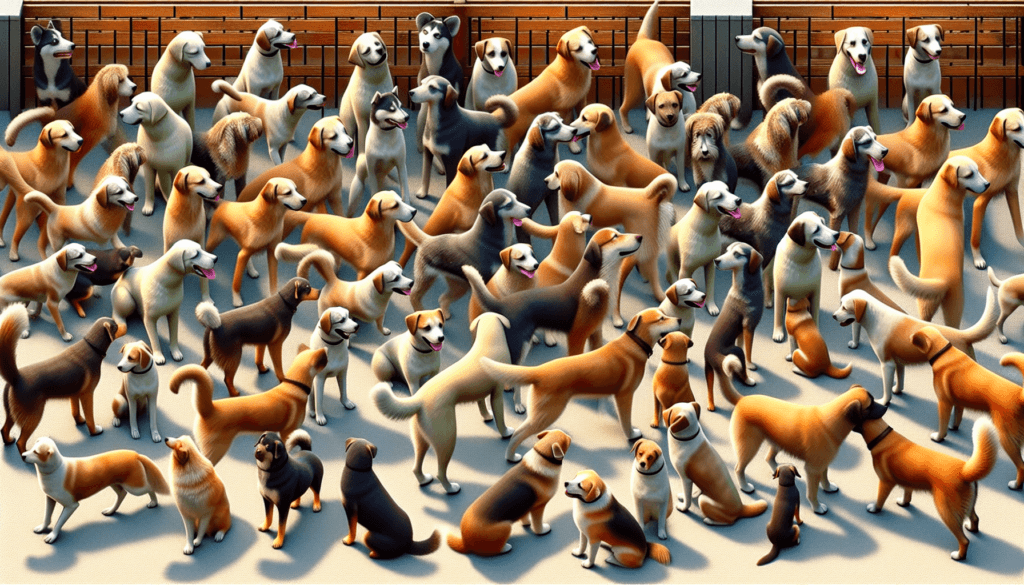In a dog community, communication plays a fundamental role in establishing relationships, resolving conflicts, and maintaining harmony. From barks and body language to subtle gestures and eye contact, dogs rely heavily on their communication skills to convey their emotions, needs, and intentions to one another. Effective communication allows dogs to form strong social bonds, recognize pack hierarchy, and establish boundaries. Without it, misunderstandings could arise, leading to aggression, anxiety, and other behavioral issues. Understanding the vital role of communication within a dog community is key to ensuring a thriving and cohesive canine society.
The Importance of Communication in a Dog Community

Understanding the Nature of Communication in Dogs
Communication plays a vital role in any social species, and dogs are no exception. As highly social animals, dogs rely on effective communication to navigate their interactions and establish meaningful relationships within their community. Understanding the nature of communication in dogs allows us to better comprehend their needs, behaviors, and emotions. Dogs primarily communicate through a combination of verbal cues, body language, and facial expressions. By paying attention to these forms of communication, we can decipher the messages our furry friends are trying to convey.
Establishing Social Hierarchies through Communication
Within a dog community, communication is essential for establishing social hierarchies. Dogs naturally form hierarchical structures, with certain individuals assuming leadership roles. Through various communication signals, such as posturing, growling, and staring, dogs communicate their social position to one another. This communication helps promote order, reduce conflict, and ensure a cooperative and orderly dog community. By recognizing these communication signals, dog owners and enthusiasts can support a healthy social structure among their pets and those they interact with.

Facilitating Cooperation and Coordination
Effective communication among dogs facilitates cooperation and coordination, allowing them to engage in various activities together. Whether it is hunting, playing, or simply exploring their surroundings, dogs rely on clear communication to work together as a team. The ability to convey intentions, desires, and boundaries through communication leads to successful interactions and enhances the overall dynamics within the dog community. By promoting understanding and cooperation, communication strengthens the bonds between dogs, fostering a sense of unity.
Enhancing Social Bonding and Relationships
Communication in a dog community plays a crucial role in fostering social bonding and developing strong relationships. Through various vocalizations, body language, and gestures, dogs convey their feelings of affection, trust, and companionship to one another. By responding appropriately to these communication cues, dogs can strengthen their bonds and establish lasting relationships. Furthermore, effective communication also allows dogs to bond with their human companions, leading to a deeper sense of connection and understanding between species.

Preventing Conflicts and Promoting Peaceful Interactions
Clear and effective communication significantly contributes to conflict prevention and promotes peaceful interactions within a dog community. By conveying their intentions and emotions through communication signals, dogs can defuse potentially tense situations. For example, a dog may use submissive body language, such as lowering their head or tucking their tail, to indicate a non-threatening stance and prevent aggression. Understanding these cues and responding appropriately helps prevent conflicts and fosters a harmonious environment for all members of the dog community.
Promoting a Sense of Community and Belonging
Communication is integral to creating a strong sense of community and belonging among dogs. By engaging in various communication behaviors, such as play bows, tail wagging, and friendly vocalizations, dogs express their desire for social interaction and connection. These communication signals not only contribute to the formation of social bonds but also create a welcoming and inclusive atmosphere in the dog community. A strong sense of community and belonging is vital for the overall well-being and happiness of dogs.

Enabling Effective Training and Behavior Management
Communication is vital in training and behavior management for dogs. Through clear and consistent communication, both verbal and non-verbal, dog owners can effectively communicate their expectations and reinforce desired behaviors. Conversely, understanding canine communication allows owners to interpret their dog’s responses and adjust their training methods accordingly. By establishing a common language through communication, dogs and their owners can work together to achieve desired outcomes, resulting in a well-behaved and happy canine companion.
Supporting Emotional Well-being and Mental Stimulation
Communication is not only crucial for physical interactions but also for supporting the emotional well-being and mental stimulation of dogs. Dogs, like humans, experience a range of emotions and desires. By effectively communicating their needs, such as the need for exercise, companionship, or mental stimulation, dogs can lead fulfilled and content lives. Understanding their communication cues and responding appropriately helps enhance their emotional well-being and provides them with the mental stimulation they require.
Significance of Non-Verbal Communication in Dogs
Non-verbal communication plays a significant role in the canine world. Dogs rely heavily on body language, facial expressions, and postures to convey their emotions, intentions, and boundaries to other dogs and humans. For instance, a wagging tail may indicate happiness and excitement, while a lowered head may signify submission or fear. By paying attention to these non-verbal cues, dog owners and enthusiasts can better understand and respond to their dog’s needs, creating a harmonious and mutually beneficial relationship.
Understanding Human-Dog Communication
While dogs primarily communicate with one another using their own unique language, understanding human-dog communication is equally important. Dogs are experts in observing and interpreting human behavior and rely on our cues and signals to understand our intentions and desires. By using consistent verbal commands, body language, and positive reinforcement, we can effectively communicate with our dogs and establish a strong bond based on trust and understanding. This mutual understanding facilitates the integration of dogs into human society and ensures a harmonious coexistence.
In conclusion, communication is the cornerstone of a thriving dog community. From establishing social hierarchies and promoting cooperation to preventing conflicts and fostering social bonds, effective communication plays a crucial role in every aspect of a dog’s life. By understanding the nature of communication in dogs, both among themselves and with humans, we can create a nurturing and inclusive environment that supports their emotional well-being, enhances their relationships, and promotes a strong sense of community. So, next time you interact with a dog, remember the importance of communication and the profound impact it has on their lives.


